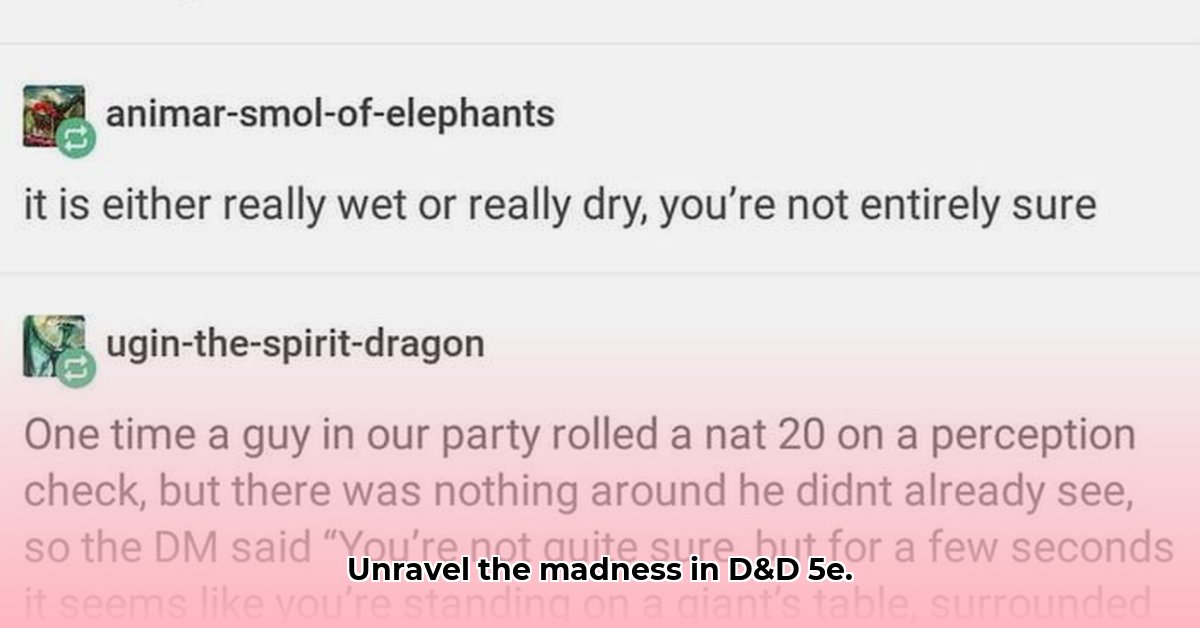
D&D 5e's standard madness rules often fall short of delivering the truly unsettling, impactful experience many Dungeon Masters crave. This guide provides a comprehensive review of existing mechanics and a step-by-step instructional guide to building your own robust, engaging sanity system, transforming your campaigns with chilling psychological depth. Let's delve into the chilling possibilities of madness in your next adventure!
Review of Existing Mechanics: The DMG's Limitations
The Dungeon Master's Guide (DMG) does offer optional sanity rules, introducing a sanity score representing a character's mental fortitude. Sanity loss, typically through failed saving throws against terrifying events, can lead to madness. However, the DMG's approach often feels underwhelming. The effects are often temporary and easily mitigated, lacking the lasting impact many DMs desire for truly immersive madness mechanics. This leaves significant room for improvement and customization.
Building a Custom Sanity System: A Step-by-Step Guide
Building a compelling sanity system requires careful consideration, balancing mechanical impact with roleplaying opportunities. It’s not just about rolling dice; it’s about enhancing your narrative and player experiences. This guide provides a practical framework:
Step 1: Defining "Sanity": Choosing Your Tracking Method
How will you represent sanity? Will you use a numerical score (allowing for granular adjustment), a tiered system (clearly defining stages of madness and easy visualization), or a condition system (simplifying tracking)? Each method offers benefits and trade-offs:
| Method | Pros | Cons |
|---|---|---|
| Numerical Sanity Score | Granular control, flexible implementation. | Can feel abstract, requiring careful balancing. |
| Tiered Sanity System | Clear visual representation of escalating madness; simple to understand. | Less flexible, potentially lacking nuance. |
| Condition System | Simplicity; easily integrated into existing condition rules. | Limited customization options; may lack granularity. |
Step 2: Sanity Loss: Identifying Triggers and Gradating Severity
What triggers a sanity loss? Witnessing horrific events? Failing crucial saving throws? Moral dilemmas? Create a system to determine sanity loss based on event severity:
| Event Type | Severity (Sanity Loss) | Notes |
|---|---|---|
| Witnessing a gruesome murder | 1d4 + 1 | Severity increases with details; more graphic = more loss. |
| Critical failure against a creature | 1d6 + 1d4 | Creature's nature impacts severity; a powerful demon is worse than a ghoul. |
| Traumatic vision | 2d6 + 1d6 | Vision's nature and intensity dictate the value. |
| Prolonged exposure to a planar anomaly | 3d6 + 2d4 | Plane's power and exposure duration influence loss. |
| Moral dilemma/difficult choice | DM's Discretion | Judged on player actions and choices. |
Step 3: Madness Effects: Mechanical and Roleplaying Consequences
Madness isn't just a number; it's a character change, impacting both mechanics and roleplaying:
- Mild Madness (1-3 points lost): Minor impairments (unsettling visions, difficulty concentrating). Primarily roleplaying elements.
- Moderate Madness (4-6 points lost): Heightened anxiety, paranoia, compulsions. Adds mechanical penalties (e.g., disadvantage on Wisdom checks).
- Severe Madness (7+ points lost): Major personality changes, debilitating conditions (rage, hallucinations). Significant mechanical impacts (e.g., disadvantage on all checks).
Step 4: Sanity Recovery: Hope Amidst Despair
How do players regain sanity? Consider methods like extended rest, powerful spells, therapy, or confronting fears. Make recovery a challenge, reflecting the struggle against mental instability.
Step 5: Integration into Gameplay: Seamless Weaving
How does your system impact combat, social interactions, and storytelling? Does low sanity impact combat effectiveness, social abilities, or decision-making? A well-integrated system adds depth without derailing the game.
Examples and Case Studies
A character witnessing a horrific ritual (losing 6 points) might enter Severe Madness, experiencing uncontrollable rage (mechanical disadvantage on attacks, potential for harming allies). This would fundamentally alter their roleplaying behavior and interactions.
Conclusion: Embracing the Madness
Remember, a successful sanity system seamlessly integrates into your campaign, enhancing your storytelling and player immersion. Experiment, adapt, and—most importantly—have fun making your players question their sanity!